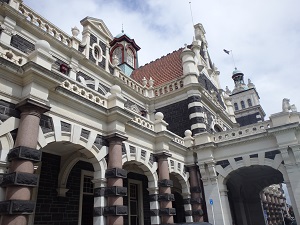
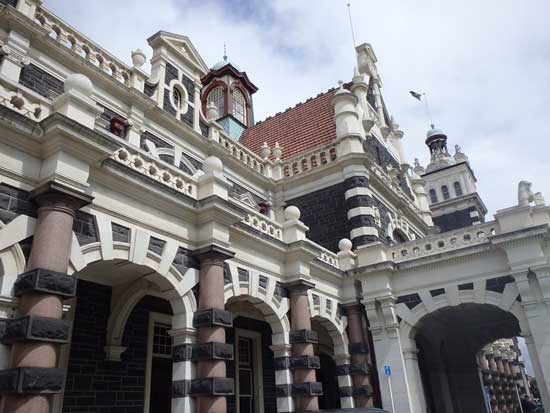
The only thing missing is the sound of bagpipes.
A morning mist hovers over the rolling hillsides. Here and there, polka dots of white sheep decorate patches of green grass, separated by brambly hedgerows.
Closer to town the mist turns to rain, darkening the stone facade of the cathedral. Lines of black umbrellas bob along the sidewalks, passing parks and pubs. Merchants display tartans in shop windows. A train whistle blows nearby.
It feels like Scotland, but it’s half a world away. This is a typical morning in Dunedin, New Zealand.
Dunedin is a modern city steeped in the heritage of its 19th century Scottish founders. It is also a gateway city for exploring the rugged landscape of New Zealand. Here on the east coast of the South Island, the Taieri Gorge Railway begins its journey into the hinterland of the Otago region.
The journey starts in style at the Dunedin Railway Station, one of the most photographed buildings in New Zealand. Built at the beginning of the 20th century, the station rises grandly in strong stripes of gray basalt and white stone. A manicured garden sits gracefully below pink granite columns and a New Zealand flag flies proudly above the copper cupola of the clock tower.
The interior of the station is delicate compared to the heavy stone exterior. The arrivals hall is bright and golden-hued, wrapped in a porcelain tile frieze. High above, a colorful stained glass window features an approaching locomotive; the same locomotive appears in profile on the mosaic tile floor.
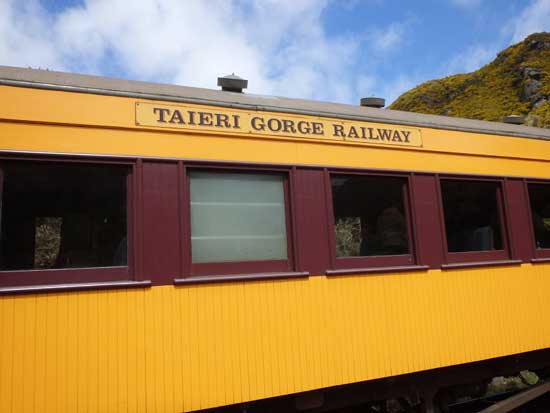
The Taieri Gorge Railway departs from the main platform. Most of the train cars are bright yellow “heritage carriages,” which are wood-clad both inside and out. A few more up-to-date carriages are painted blue and coupled near the modern diesel electric engine.
From the station, the train travels slowly south through the outskirts of Dunedin. Gradually, suburbs give way to undulating pastureland. As the tracks curve northwest, a series of tunnels signal that the terrain is changing and the train picks up speed.
Suddenly, as the train emerges from a gully, the Wingatui Viaduct appears ahead. It’s a towering wrought iron bridge spanning almost 650 feet. Six trestles of various sizes support the tracks over 150 feet above the streambed. Passengers crane their necks to get the best view, as the bridge is the largest and most impressive man-made feature on the journey.
Near the Wingatui Viaduct, the train tracks begin to trace alongside the Taieri River. Craggy cliffs replace gentle hills, and the terrain gets rougher and more uneven as the train continues north.
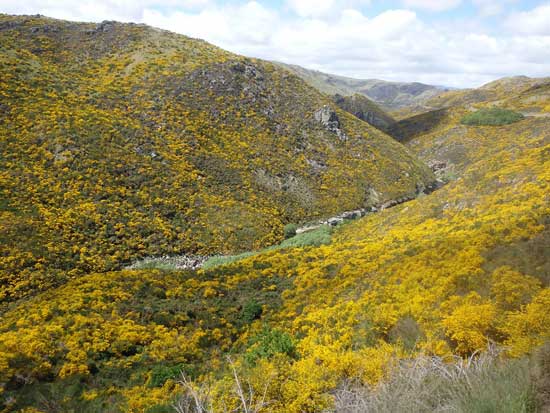
Wisps of native grasses begin competing for space in the rocky topsoil. Suddenly, a golden blaze of blooms explodes over the landscape as far as the eye can see. The blooms are the flowers of the spiny gorse shrub, originally imported by European settlers as a hedge plant. The gorse thrive in the temperate climate and now grow wild. Today, gorse infests hundreds of acres. Even though the weed is unwelcome, it gives the Taieri Gorge a distinctive yellow-gold palette.
This colorful but forbidding landscape along the Taieri River was largely inaccessible in the late 19th century. When the first section of the railway opened in 1889, it connected sheep runs and farms that could not be reached reliably by road. By providing both a means of communication and transportation, the railway contributed significantly to the development of the Otago region. Today, the train rolls past long abandoned stations where early settlers picked up supplies and shipped livestock and farm produce to points north and south.
Almost two hours after leaving Dunedin, the railroad climbs high above the Taieri River, threading its way along jagged ridges. With the river winding below, the train passes through The Notches, rocky outcrops laced together by a series of trestle bridges. The railway reaches its highest elevation near here, and the view into the narrow, deep gorge below is the most dramatic on the journey.
Emerging from the gorge at Pukerangi, the train locomotive swiftly switches ends for the return trip to Dunedin. On the way back, passengers linger with their cameras on the viewing platforms between carriages. Some comment on the natural beauty of the gorge, while others focus on the engineering feat of the railway. Everyone agrees that the vintage train journey offers an unrivaled glimpse into the natural environment of New Zealand’s South Island.
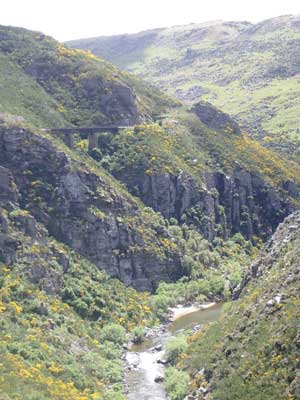
If You Go
The Dunedin-Pukerangi half-day return journey on the Taieri Gorge Railway is available most days year-round, twice daily (9:30 a.m. and 2:30 p.m.) during the summer (October-April). Ticket prices start at NZ$89, and booking is available at the Dunedin Railway Station or online at www.taieri.co.nz.
A selection of light foods and beverages, (including beer and wine,) are available for purchase at the snack bar on each train. To avoid standing in line during the best scenery, make purchases early in the journey.
Pre-recorded commentary onboard can be difficult to hear. Brochures including a route map are available from the train staff.
The Dunedin Railway Station is a 5-10 minute walk from the Octagon, the central plaza of Dunedin.
Author Bio: Catherine Fancher is a Dallas-based attorney who decided to take some time off in 2012. She sold her house, put everything in storage and traded her high heels for hiking boots. 29 countries later, she is still traveling.
[mappress mapid=”887″]
- What It’s Like to Live as an Expat: Lake Chapala, Mexico - April 18, 2024
- Top 5 Spots for Stargazing in North Carolina - April 17, 2024
- The Low-Key Magic of Ghent, Belgium - April 17, 2024
